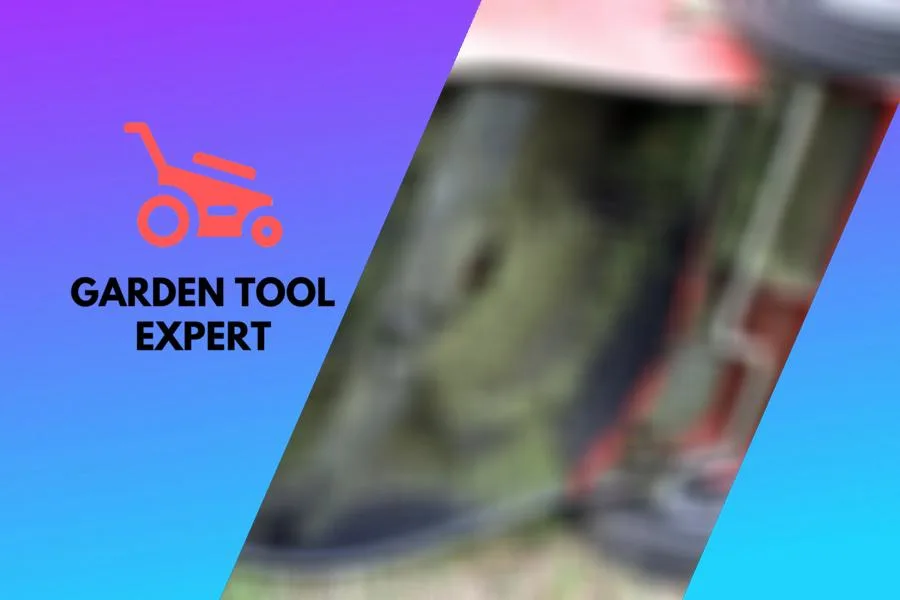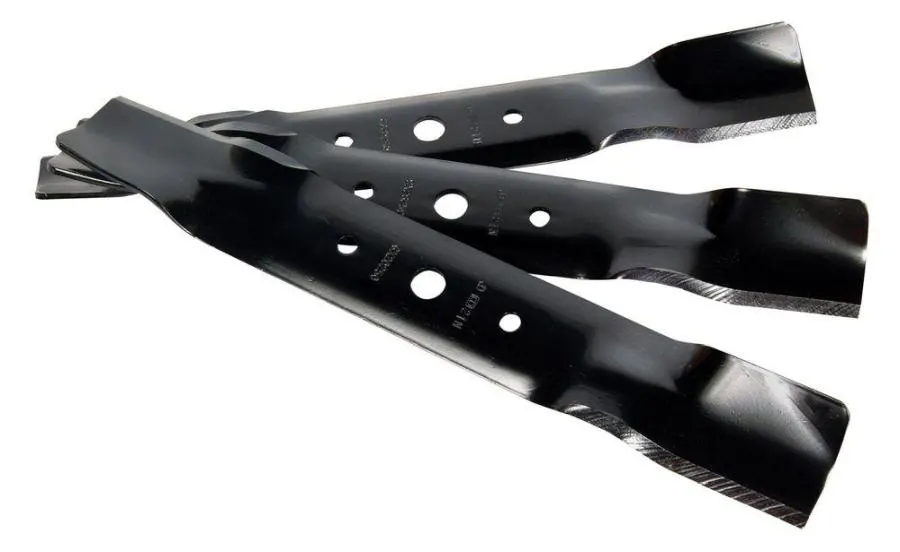Blade toughness is a vital feature worth considering when shopping for a good lawnmower. Thus, most homesteaders and commercial lawn mowing service providers often ask; do I go for tempered or annealed blades? Also, can tempered blades stand rigorous use on tough rocky turf yet still last long? Well, because blade tempering always pops up in most debates, we wanted to set the record straight once and for all. It is especially because tempering touches on the tensile strength and toughness of the blades.
Are Lawn Mower Blades Tempered?
Yes, lawnmower blades are tempered. Tempering is used to make the blade durable, stronger, and tougher. However, the temperature of doing so often depends on the type of metal. Steel is the preferred metallic material for making lawnmower blades. But alloyed carbon blades are equally common. Alloying improves tensile strength and guard metals against corrosion.

If you are a homesteader looking for the best lawn mower, blade tempering is something you wouldn’t want to easily wish away. Think about a situation where blades of your brand new lawnmower snap with the first use? Will you seek a refund, especially if a sales agreement contains a money-back guarantee clause? Or, will you want to find out more about blade toughness and brittleness? The truth is that without asking the right questions, you would end up spending more money on equally substandard spare blades. Nevertheless, while your taste and preference could overshadow decision-making at the eleventh hour, this post helps you understand critical considerations such as lawn blade tempering. Read on to learn more.
Contents
Understanding Blade Tempering
Blades tempering is a discussion that we indulge in quite often, especially when seeking advice on the best lawn mower blades, knives, tomahawks, axes, and machetes. The big question is, what does it mean? Well, tempering is a process of heating blades. It follows a process of hardening alloys (iron-based) or steel. Often, the main reason for tempering is to reduce the hardness and brittleness of the metal.
There is no definite temperature for tempering, albeit it should take place below a critical point. For starters, the critical point is a thermodynamics term that denotes melting. Refer to heating metals in this case. In companies like Fisher Barton Blades Inc., where blade manufacturing is the main industrial activity, terms like austempering are often used to denote hardening and strengthening lawn mower blades. You would, therefore, want to ask, how is it different from conventional blade tempering?
Tempering lawn mower blades often involves a quench-temper-heat treatment process. The end metallic product is Martensite. However, it is more of a surface treatment method that may not be as effective as purposed. On the other hand, austempering produces uniform blade hardness and tensile strength. The end product is bainite, a tougher and less brittle blade. You should also note that the heat treatment processes of lawn mowing blades vary from one blade manufacturer to another. You can call it standard tempering practices, and that’s okay.
Importance of Tempering Lawn Mower Blades
So, what’s all the fuss about? Does tempering add value to lawnmower blades? Well, blades that go through the process should exhibit the following characteristics:
- Durability: Tempered blades should be durable and hardly sharpened.
- Stronger: You should have a stronger and durable lawnmower blade after tempering. Most importantly, the physical strength of such blades should be uniform both inside and outside the metal.
- Harder: On the Rockwell hardness scale, tempered blades should exhibit a hardness rating of between 35 and 48. It means you will have a less brittle blade that will not break after a few days or weeks of use.
- Anti-wear: Moreover, tempered blades should exhibit supreme anti-wear features.
- Low rate of distortion: They should have a low rate of distortion, so you don’t have to worry about mowing the grass on rocky grounds.
Does tempering affect the sharpness of lawn mower blades?
You would want the blades of your lawnmower to be very sharp, cutting grass with great ease and speed. And so, questions most homesteaders ask is are tempered blades sharper? Are they easy to sharpen? The truth is that when you temper blades, the mere fact that they become tougher and less brittle means you won’t have to worry about how sharp your blade is for a long time.
Tempered blades retain their sharpness for a long time. However, should they become blunt, use a recommended file to sharpen them. But let’s say another topic on how to sharpen lawn mower blades should help you understand more. You can also check out lots of videos that give a detailed explanation of sharpening blades.
Tempering and Hardening Lawn Mower Blades: What’s the difference?
Whether you are looking to produce a Martensite or a bainite blade, either through a tempering or austempering process, the big question is will you end up with hardened or toughened steel? Also, what’s the difference between hardening and toughening?
Well, hardened blades are not necessarily tempered. However, tempered lawn mower blades exhibit a characteristic of hardness. It means, for blades to undergo a proper tempering process, they must first of all pass through a hardening process. The end product after a hardened process is often referred to as Martensite. Some manufacturers stop at this stage, especially if it is their standard tempering process. It could also depend on the purpose for which you need a hardened blade.

After hardening steel, the manufacturer of lawn mower blades then cools it down in natural oil or water to temperatures below 200 degrees Celsius down. Temperatures for hardening steel can go beyond 700 degrees Celsius, which as you would discover shortly, is not the same as that for tempering blades.
Now, when it comes to tempering blades, toughening and making hardened steel take precedence. Let’s quickly mentioned that hardened steel is highly brittle hence should not be used without toughening. Weak tensile strength is another feature worth noting. Tempering, therefore, becomes necessary. Since the cooling of hardened lawn mower blades takes place below 200 degrees Celsius, the temperature for toughening and making them less brittle should not exceed 300 degrees Celsius. It could be higher or lower depending on the manufacturer.
Moreover, tempering should only take a few hours. The catch here is that while tempering should improve tensile strength (toughness) and reduce the brittleness of metallic crystals, doing it excessively would make blades softer. The next question is, are softer blades better? Well, your guess is as good as ours. Softer lawn mower blades would become blunt quickly. It also answers the question of are tempered blades wear-resistant? Blades that go through a rigorous process of tempering do not wear out fast hence last long.

Do tempered blades crack?
If the blades of your lawnmower have not cracked, you did buy them from a reputed manufacturer. Tempering helps guard against the cracking of blades. Blades that crack denote poor quality, something you wouldn’t want to experience as soon as you start mowing your lawns. With a toughened blade, you should expect a higher tensile strength. It is a case of metallic crystals in a blade stretching beyond their elastic limit to accommodate tough mowing tasks.
Occasionally, blades of lawn mower blades crack, especially after hitting a rock in your backyard. With such incidences, tempering often comes into disrepute. For example, why would the blades be so brittle that they break into shrapnel? Should we, therefore, worry about the quality of moving blades?
The truth is that not all blades of lawnmowers are tempered. Some are only hardened; hence their tensile strength cannot withstand rocky lawns. That should take you back to explain the difference between tempering and austempering. Because standard practices of hardening and toughening blades vary from one company to another, you should emphasize putting money on supreme quality blades. Online discussion forums would help you make significant steps toward making the right choice but not entirely.
You must dig deeper into a company’s manufacturing processes to better your understanding of hardening and tempering. Moreover, ask for recommendations on the best blades from experienced homesteaders, so you don’t end up purchasing substandard blades.
Final Thoughts
We know choosing the best lawn mower blades can be a real hard hassle. Buying soft blades that get blunt quickly to replacing worn-out ones with highly brittle ones, tough situations call for extra awareness. Thus, understanding blade tempering becomes an important step as we advance. You may not need tougher and harder blades for your backyard lawn, but for companies that provide lawn moving services, tempered blades are a plus. They save you money on maintenance costs, not to mention their durability and ability to remain sharp for long.
The process of tempering notwithstanding improves the quality of blades. If you haven’t bothered about buying hardened steels, you may have to check if your next purchase is tempered. Apart from checking manufacture specifications on product labels, also consider the Rockwell hardness scale. The temperature at which tempering happens defines how long they would last and the resistance to wear. Remember that blades of lawnmowers can be steel or alloyed carbon, both of which should dictate the process of tempering.

Does tempering affect the sharpness of the blade?
Yes, tempering does affect the sharpness of the blade. Tempering makes the blade tougher and less brittle, ensuring that it retains its sharpness for a longer period.
What should I look for in terms of blade tempering when buying a new lawnmower?
When buying a new lawnmower, look for tempered blades. They are more durable, stronger, and less brittle. This will ensure that your lawnmower blade lasts longer and remains sharp for extensive use.
Can tempered blades still crack under pressure?
Yes, tempered blades can still crack under pressure if not properly manufactured. It is crucial to ensure high-quality blades to prevent such issues.
What is the ideal Rockwell hardness rating for tempered blades?
The ideal Rockwell hardness rating for tempered blades is between 35 and 48. It ensures durability, strength, and resistance to wear, making them perfect for tough mowing tasks.
What are the benefits of using tempered blades for a commercial lawn mowing service?
Tempered blades are indeed the way to go for commercial lawn mowing services. They provide durability, strength, and a longer lifespan, making them a valuable investment for your business.
Are lawnmower blades always tempered?
Yes, lawnmower blades are tempered to make them durable, stronger, and tougher. The temperature of tempering depends on the type of metal used, such as steel or alloyed carbon. Hope this clarifies it for you!
Are there any disadvantages to using tempered blades?
Thank you for your question, Neil. Yes, there are disadvantages to using tempered blades, such as the risk of making them softer through excessive tempering, which could lead to quicker blunting. Be sure to choose wisely.
Can I temper lawnmower blades at home?
Yes, you can temper lawnmower blades at home, but it is essential to consider the type of metal and the process involved for durability and longevity.
What is the difference between tempered and annealed blades?
Hi Penny, lawn mower blades are tempered to make them durable, stronger, and tougher. Steel is the preferred material for making these blades, ensuring they are long-lasting and reliable for your lawn care needs.
Do tempered blades last longer than annealed blades?
Yes, tempered blades last longer than annealed blades. Tempering improves durability, strength, and toughness of the blade, making it more resistant to wear and less likely to break.
How often should tempered blades be sharpened?
Yes, lawnmower blades are tempered for durability, strength, and toughness. Blade tempering is crucial for lasting long without frequent sharpening. It enhances uniform hardness, making them less brittle for tough use.
What is the critical point in the tempering process?
Thank you for your question, Alfredo. The critical point in the tempering process is below the point of melting. It is essential for increasing blade durability and toughness.
Are tempered blades more expensive than annealed ones?
Yes, tempered blades are usually more expensive than annealed ones due to the additional process of heating and toughening involved in the production.
How can I learn more about the tempering process for lawnmower blades?
Thank you for your interest in the tempering process for lawnmower blades. Blades are tempered for durability, strength, and toughness. The temperature varies based on the metal type. Hope this helps!
Are tempered blades more resistant to wear and tear?
Yes, tempered blades are more resistant to wear and tear because they are durable, stronger, and tougher. The process of tempering improves blade quality, making them last longer and less likely to break.
Do tempered blades require special maintenance?
Yes, tempered blades require special maintenance to ensure durability, strength, and sharpness. Regular sharpening and proper care will keep them in top condition for longer use.
How can I tell if a lawnmower blade is tempered?
Yes, lawnmower blades are tempered to make them durable and stronger. The temperature of tempering varies based on the metal used. Steel and alloyed carbon blades are common choices, improving tensile strength and resisting corrosion.
Do all manufacturers use the same tempering process for blades?
Yes, most manufacturers use a tempering process for blades to make them durable, stronger, and tougher. The temperature of tempering depends on the type of metal used, usually steel or alloyed carbon.
Is there a specific temperature range for tempering lawnmower blades?
Yes, lawnmower blades are tempered to make them more durable, stronger, and tougher. The temperature of tempering varies depending on the type of metal used. Hope this clarifies your query!
What are the advantages of having tempered lawnmower blades?
Thank you for your question, Joseph. Tempered lawnmower blades are advantageous as they are durable, strong, and resistant to wear. This ensures a longer blade life and less frequent sharpening.